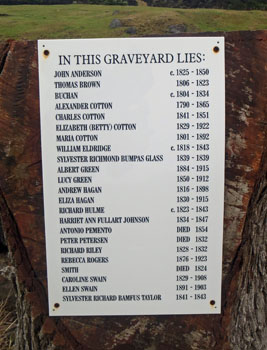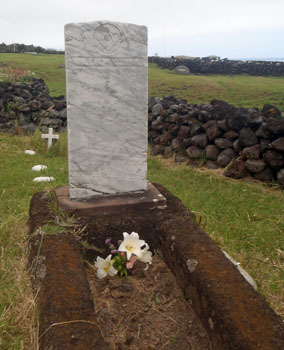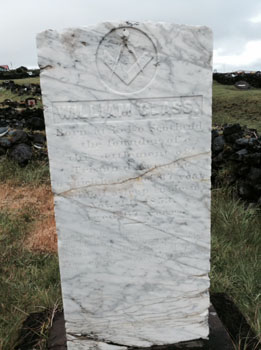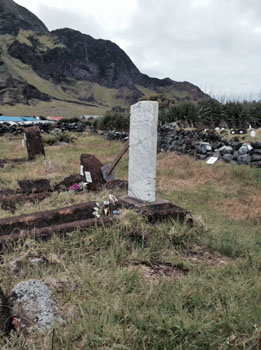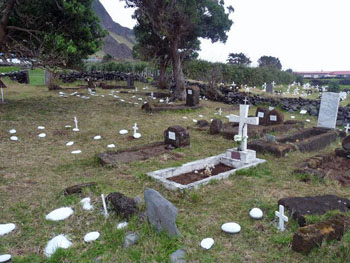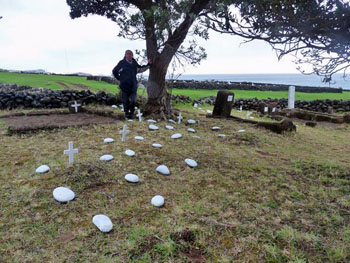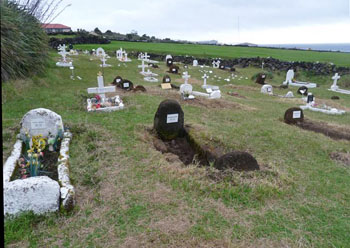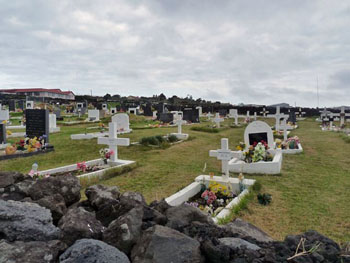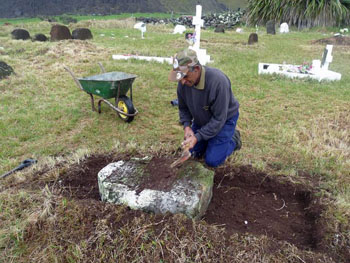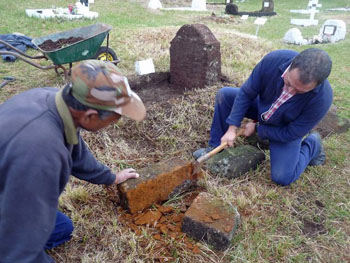Guide to the Tristan da Cunha Cemeteriesand work to restore graves and maintain the cemetery environment |
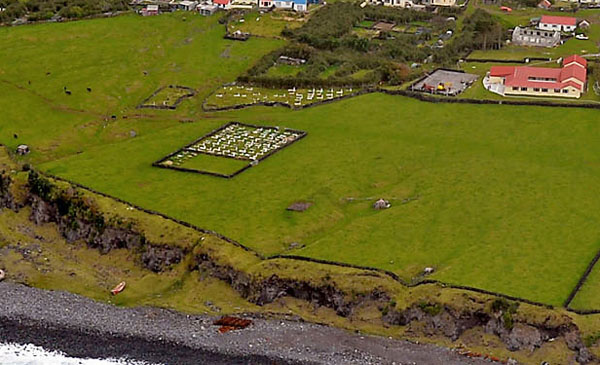 |
|
Aerial photo taken in 2013 showing the three Tristan da Cunha Cemeteries located within the American Fence field and overlooked by St Mary's School (the larger red-roofed building top right). The First Old Cemetery is the smaller walled enclosure on the left (east) side. The Second Cemetery (containing graves from 1923 to August 1975) is sited a short distance to the right (west) and is bounded on the south side by a flax hedge and tapers to a point towards the school. The Third Cemetery (containing graves from September 1975) is the larger walled rectilinear enclosure, north of the Second Cemetery, and with an extension on the seaward side. |
|
|
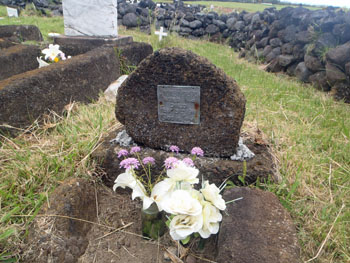 |
December 2011 images
|
Dawn Repetto describes how the Tristan Community deals with deathWhether family or not a passing touches the hearts of the whole community and this is when you see islanders not only as a community, but as a family. The flag is flown at half-mast and if this occurs on a weekday work will be stopped as a mark of respect. The Albatross Bar closes for that evening and there are no celebrations unless permitted by immediate family. A group of young ladies will visit island homes to collect flowers that will be made into wreaths by some of the island ladies. With every funeral a small service is held at Camogli Hospital for relatives and friends, before the departed is carried to the Land Rover waiting outside and then driven through the village to St Mary's Church. The Reverend and Lay Ministers lead the way with the mourners following close behind. After the church service the procession goes to the cemetery, where the community with heavy hearts say their final goodbyes. Islanders will then visit the home of the bereaved to give them comfort and sympathy. As with any event on Tristan, the community pulls together whatever the occasion and this keeps us strong. |
|
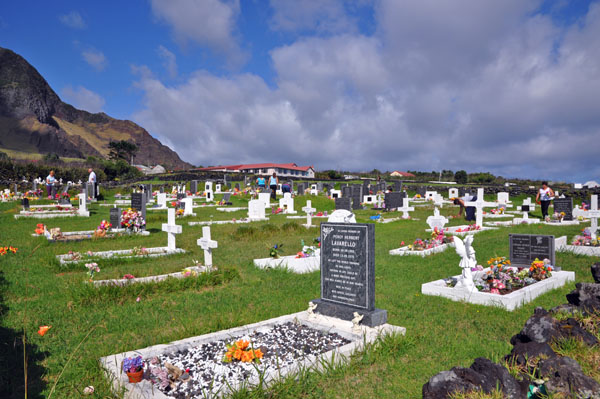 |
|
| Photograph taken by James Glass prior to Mothering Sunday 2013 showing a typical autumn scene in the Third Cemetery with Islanders busy ensuring that graves of their loved ones are adorned with fresh flowers and the grave yard is in good order. |
Restoration Work on William Glass' Grave November 2014Report from Dawn Repetto |
|
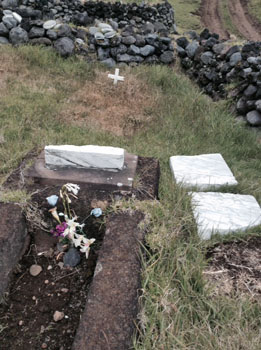 |
In late October 2014 we were notified that William Glass's headstone top had broken off into two blocks. This was very sad news for us as this is a part of our history and is understood to have been sent to the island from America by William's family* in the decade after his death from cancer in 1853 at the age of 67. The impressive gravestone was certainly installed by 1867 when Prince Alfred, second son of Queen Victoria, and the first Duke of Edinburgh visited Tristan and in whose honour the Settlement was named. In consultation with Robin Repetto and Victor Cinnamon it was decided we may could epoxy the pieces together. This has now been done and seems to be holding. The plan is to reinforce the back with some iron support or possibly even concrete a backing onto the plaque to support it. We hope this sort of support will protect it against Tristan's harsh weather. Photos from Robin Repetto show the damaged headstone left and images of the repair below. |
|
|
Restoration of Tristan Cemeteries in 2009Report from Dawn Repetto and Photos from Robin Repetto |
|
| During winter 2009 work was undertaken to restore and identify all the unmarked graves at the cemetery. It was a very arduous task but was successfully completed with the help of many people, to which we are all grateful. In particular Lars Repetto helped identify unmarked graves and Alan Waters compiled a record of graves in the cemeteries when he served as Administrator on the island in 1995 which proved very useful. | |
Cemetery No 1 - (1822 – 1923) posed the biggest problem as many of the graves were not discernable and although we knew who was buried there, it proved impossible to identify which plot is dedicated to which person. To overcome this problem one large plaque was ordered which read “In the Graveyard lies…”. Each plot was then marked with a small white wooden cross and some large white painted stones from the beach. Photo of the First Cemetery |
|
|
Photo of Lars Repetto overlooking the First Cemetery during the 2009 restoration work. Anglican Lay Minister Lars advised on the location of many of the older graves. |
Photo of Cemetery No 2 - (1923 – 1975) |
|
|
Photo of Cemetery No 3 – (1975 onwards) |
Work was carried out to mark out all three cemeteries with wooden markers containing people's names. This task was made easier with the help of Mr Waters map. After completing this, a few of the older generation in the community visited the cemeteries to look at the wooden markers and see if they were in agreement. A list was made of all graves requiring plaques and this was ordered from Table Bay Marine in Cape Town. With the help of the “Working Girls” and other workers, cemeteries 1 and 2 were tidied up, as there were rose bushes, debris and long grass in some areas. This took quite a few days to complete as certain parts had become very overgrown. Fortunately all 76 plaques and 20 stakes arrived from Cape Town on the Edinburgh in July. Plaques were attached to the headstones and for those graves containing no headstone; the metal stakes were used to hold their plaques. |
|
|
|
|
These four photos show Herbert Glass (with Allan Swain in the photo above right) restoring an old grave from soft stone. This is how it used to be done in the olden times, and you can see Herbert shaping the soft stone (a volcanic tuff also used for building house gable ends). Today graves are cemented into a rectangle and filled with soil or pebbles in the middle. A marble headstone is then ordered from South Africa and placed at the top of the grave. A lot more grander then it used to be, but I must say I do like the soft stone ones. |
|
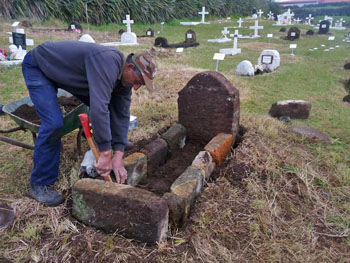 |
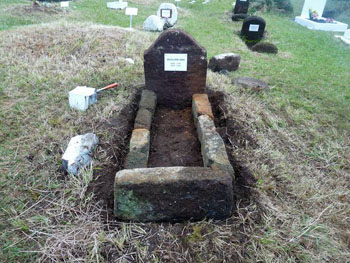 |
The Island community takes great pride in the island cemeteries and visits them every weekend with flowers. This project was undertaken not because the Tristan Community had forgotten their ancestors, but with the eruption of the 1961 volcano family plots were forgotten. When Islanders returned the older generation had passed away and younger family members were unaware who was buried where (I believe in the olden days it was forbidden for children to attend a funeral). Now that the cemeteries have been restored Islanders will continue to look after them as they do the present cemetery. Last but not least special thanks to Marilyn Crawford, for her ”Tristan Da Cunha Big Book of Family Trees” printed in January 2009, which came in time to help us identify family members, dates and which people were related. |
|

